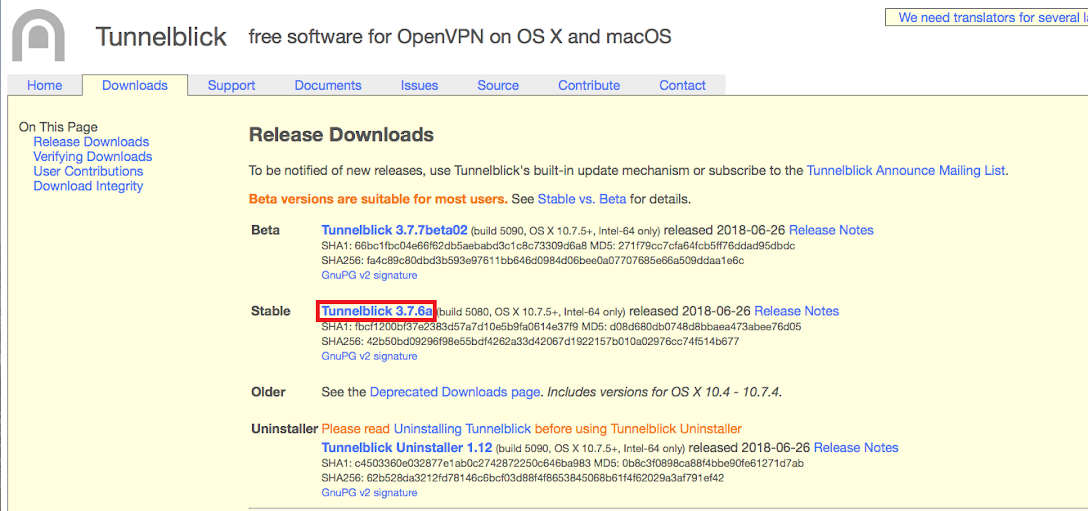

- TUNNELBLICK CONFIGURATION FILE WITH EMBEDDED CERT HOW TO
- TUNNELBLICK CONFIGURATION FILE WITH EMBEDDED CERT INSTALL
- TUNNELBLICK CONFIGURATION FILE WITH EMBEDDED CERT SOFTWARE
Start by generating the OpenVPN server certificate and key pair. Next, we will generate our server certificate and key pair, as well as some additional files used during the encryption process. Step 5: Create the Server Certificate, Key, and Encryption Files We now have a CA that can be used to create the rest of the files we need. Organizational Unit Name (eg, section) :Ĭommon Name (eg, your name or your server’s hostname) : If you enter ‘.’, the field will be left blank. There are quite a few fields but you can leave some blankįor some fields there will be a default value, What you are about to enter is what is called a Distinguished Name or a DN. You are about to be asked to enter information that will be incorporated Just press ENTER through the prompts to confirm the selections: Since we filled out the vars file, all of the values should be populated automatically. This will initiate the process of creating the root certificate authority key and certificate. Make sure we’re operating in a clean environment by typing: clean-all, I will be doing a rm -rf on /home/sammy/openvpn-ca/keys You should see the following if it was sourced correctly: Now, we can use the variables we set and the easy-rsa utilities to build our certificate authority.Įnsure you are in your CA directory, and then source the vars file you just edited:

When you are finished, save and close the file. To keep this simple, we’ll call it server in this guide: While we are here, we will also edit the KEY_NAME value just below this section, which populates the subject field. It should look something like this:Įdit the values in red to whatever you’d prefer, but do not leave them blank: Towards the bottom of the file, find the settings that set field defaults for new certificates. We only need to worry about a few of these. Inside, you will find some variables that can be adjusted to determine how your certificates will be created. To configure the values our CA will use, we need to edit the vars file within the directory. Move into the newly created directory to begin configuring the CA: To begin, we can copy the easy-rsa template directory into our home directory with the make-cadir command: In order to issue trusted certificates, we will need to set up our own simple certificate authority (CA). This means that it utilizes certificates in order to encrypt traffic between the server and clients.
TUNNELBLICK CONFIGURATION FILE WITH EMBEDDED CERT SOFTWARE
The needed software is now on the server, ready to be configured.
TUNNELBLICK CONFIGURATION FILE WITH EMBEDDED CERT INSTALL
To update your server’s package index and install the necessary packages type: We will also be installing the easy-rsa package, which will help us set up an internal CA (certificate authority) for use with our VPN. OpenVPN is available in Ubuntu’s default repositories, so we can use apt for the installation. To start off, we will install OpenVPN onto our server.

When you are ready to begin, log into your Ubuntu server as your sudo user and continue below. The linked tutorial will also set up a firewall, which we will assume is in place during this guide. You can follow our Ubuntu 16.04 initial server setup guide to set up a user with appropriate permissions. You will need to configure a non-root user with sudo privileges before you start this guide. To complete this tutorial, you will need access to an Ubuntu 16.04 server. This tutorial will keep the installation and configuration steps as simple as possible for these setups. In this tutorial, we’ll set up an OpenVPN server on a Droplet and then configure access to it from Windows, OS X, iOS and Android. OpenVPN is a full-featured open source Secure Socket Layer (SSL) VPN solution that accommodates a wide range of configurations. You can circumvent geographical restrictions and censorship, and shield your location and any unencrypted HTTP traffic from the untrusted network. When combined with HTTPS connections, this setup allows you to secure your wireless logins and transactions. The traffic emerges from the VPN server and continues its journey to the destination. Want to access the Internet safely and securely from your smartphone or laptop when connected to an untrusted network such as the WiFi of a hotel or coffee shop? A Virtual Private Network (VPN) allows you to traverse untrusted networks privately and securely as if you were on a private network. Posted592.8k views VPN Ubuntu Ubuntu 16.04
TUNNELBLICK CONFIGURATION FILE WITH EMBEDDED CERT HOW TO
How To Set Up an OpenVPN Server on Ubuntu 16.04


 0 kommentar(er)
0 kommentar(er)
